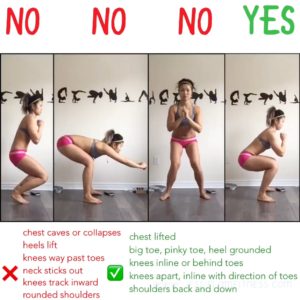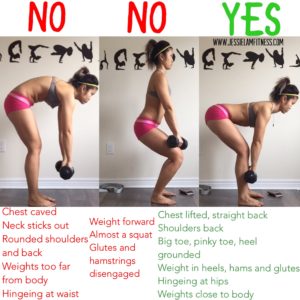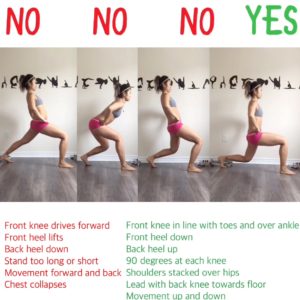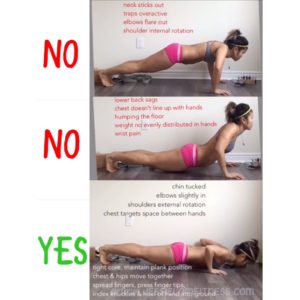***photos coming soon. post still under construction*** I’m not assuming everyone is doing everything “wrong”, and I am not always perfect either, but a nice reminder and/or a different way to look at things is always refreshing.
As always, there are exceptions to every rule, more than one way to do things, and dozens of variations to one exercise. It also depends on the person, their structure, movement limitations and patterns, goals etc.
But there is a difference between intention, control, and mindfulness – and the other side of the coin – sloppy, misguided/unaware/uneducated, and careless.
In this post, I’ll be breaking down some of the common exercises and showing incorrect and correct ways to to do them, as a general guide.
As usual, please consult a doctor before beginning any exercise routine or diet change.
Hope you find this helpful!
SQUAT
| NO | YES |
| chest caves or collapses | chest lifted, strong t spine |
| heels lift | big toe, pinky toe and heel grounded |
| neck sticks out | chin tucked |
| knees way past toes | knees inline or behind toes |
| knees knock inward | knees apart, lining up with direction of toes |
| core and glutes disengaged | belly tight, glutes engaged |
| rounded shoulders | shoulders back |
| toes opened out slightly, to your comfort | |
| A safe depth is generally having the thighs parallel to the ground or even slightly higher to start. If your hips and ankles are more mobile, you may be able to squat much lower. Also, depending on the type of squat you are doing, how much weight, number of reps and tempo, that can all affect the squat. The way your body is built also affects these guidelines, for example, if you femor (thigh bone) is longer than typical, your knees may have no choice but to go past your toes, which is completely safe for YOUR body. Many people also talk about the butt wink, where your lower back tends to dip or tuck under if you squat too low. That’s a separate topic and debate, but if you’re in an unloaded position, it likely won’t cause much harm compared to being in a loaded position. | |
DEADLIFT
| NO | YES |
| chest caves or collapses | chest lifted, strong t spine, shoulder blades back |
| weight forward | big toe, pinky toe and heel grounded, weight in heels |
| neck sticks out | chin tucked with gaze forward |
| looks like a squat, not enough focus on posterior chain | drive hips further back to target glutes and hamstrings more |
| rounded shoulders and back | flat back, neutral spine |
| core and glutes disengaged | belly tight, glutes engaged |
| knees cave in | knees apart, lining up with direction of toes |
| weights too far from body | weights very close to body |
| hinging at waist | hinging at hips |
| The deadlift is bit more complex but when done correctly, can be one the best exercises for your posture, core, hamstrings and glutes development. It is personally one of my favourite exercises. One of the biggest mistakes I see is when people end up turning it into a squat, loading the quads and breaking at the knees. You should feel the core contract, hamstrings stretch and contract, and almost like you’re about to fall backwards – but keeping you toes on the ground so you don’t actually fall. Keeping the chest lifted and shoulder heads back and down will also help. The photo above is a stiff leg deadlift | |
LUNGES
| NO | YES |
| front knee drives forward | front knee in line with front toes and over the front ankle |
| front heel lifts | front heel down |
| back heel drops | back heel lifted, pushing with balls of feet |
| stance too long or short | 90 degrees at each knee |
| back arches and belly pours out | shoudlers stacked over hips, ribs pulled in |
| shoulders round forward | lead with the back knee towards the floor |
| movement forward and back | movement is up and down |
| Despite all the hate this exercise gets because it hurts so much and they aren’t very fun to do LOL, the is a great bi-lateral exercise, challenging your balance and building strength in the legs and glutes. This is one of those exercises that can be easily modified to be made accessible for everyone. Keeping the feet hip distance is a general guideline, but taking the stance wider can help if you’re still working on balance. | |
TRX ROWS – Neutral Grip
| NO | YES |
| neck and upper traps tense | shoulders and neck relaxed |
| head drops back | spine is neutral, maintaining plank position |
| head of shoulders come forward | roll shoulder heads back |
| no activation between shoulder blades | engage rhomboids and allow some movement in scapula |
| butt sags or hips thrust | tuck butt and maintain plank |
| over pull, aggravating wrists | elbows line up with torso or slightly back |
| hand position finished too high or low | elbows roughly 90 degrees, hands finish around chest level |
| pulling too much with arms | initiate pull with back muscles |
| Another favourite exercise of mine, any back exercise in general I love. Nothing screams strong and fit like a solid back! The TRX is a great exercise tool that you can travel with, use almost anywhere, just by lifting a portion or your entire body weight! The main 2 things I emphasis is to focus on the muscles being worked: the BACK! and to maintain a straight and neutral posture, like a plank, at the start and the end, and in between each rep. One other common thing I see with beginners is the “overpull” and a weird position of the hands at the end of the rep. Dont compensate with the arms, wrists or shoulders. USE THE BACK MUSCLES | |
TRX ROWS – Wide, Overhand Grip
| NO | YES |
| same as above but adding elbows too high or flared out | elbows slightly down, towards body, activating serratus and lats |
SKULL CRUSHERS
| NO | YES |
| hyper lordosis | bring back closer to bench |
| shoulders hiked towards ears | shoulders and beck relaxed |
| elbows flare out | squeeze elbows in like you’re squeezing a beach ball, elbows pointed towards feet |
| bar not targetting forehead | target bar to forehead (hence the name SKULL crushers) |
| grip too wide | grip is approx shoulder distance |
| a classic bodybuilding/pumping iron exercise – another favourite! I don’t do as much isolation work anymore, but I do like to incorporate skull crushes to my routines. It’s not as isolated as you may think, especially with full range and a challenging weight, you need you core to stabilize the spine so your back doesn’t arch too much | |
BENT OVER ROWS
| NO | YES |
| chest caves or collapses | chest lifted, strong t spine, shoulder blades back |
| neck sticks out | chin tucked with gaze forward |
| knees drive forward | sit weight in hips |
| rounded shoulders and back | flat back, neutral spine |
| weights too far from body | weights very close to body |
| hinging at waist | hinging at hips |
| elbows flare out | elbows back and up |
| torso too high | torso parallel or close to parallel to ground |
| tailbone tucked | lift tailbone |
| this setup is very similar to the deadlift, so it’s also been called the ‘deadrow.’ Like the deadlift, this exercise can be very beneficial to build back strength and posture when done correctly. | |
PUSH UPS (CHEST)
| NO | YES |
| neck sticks out | chin tucked |
| traps over active | neck relaxed |
| elbows flare out and internal rotation | elbows slightly in and external rotation |
| chest doesn’t line up with hands | chest targets space between the hands |
| lower back sags | core engaged, maintaining a plank position at top and bottom of push up |
| look like you’re humping the ground or doing the worm | chest and hips move together at the same time |
| weight not distributed in hands properly, too much pressure in wrist | spread fingers, press finger tips, index knuckle and heel of hand into ground, serratus engaged |
| My favourite exercise nexts to pull-ups! This doesn’t just work the arms, it builds strenght in the core, wrists, legs, and back. You NEED a solid back to do a proper push up. I can preach about the proper way to do a standard push up enough. Check my other posts and videos for more details! | |
TRICEP PUSH UPS (Chaturanga)
| NO | YES |
| elbows flare out | same as above but elbows squeeze in and point towards feet |
PLANK
| NO | YES |
| shoulders hiked up | shoulders away from ears and stacked over elbows |
| neck sticks out | chin tucked |
| lower back sags | tuck pelvis and keep spine neutral |
| butt too high or too low | drive elbows into ground and pull back to activate lats (RKC plank cues) |
| legs disengaged | squeeze thighs |
| core disengaged | pull lower belly in |
| upper back sags | lift the upper back (hollow back) |
| This is a great core exercise. You already know that crunches generally SUCK and are not the key to 6 pack abs. I’ve posted about this before, so that’s another conversation. The plank works the entire body and promotes strength, stability, integrity, and is the foundation of pretty much any exercise you do. (like the TRX rows and kettlebell swings) | |
Check my post for tips on push ups and planks!
PULL-UPS
| NO | YES |
| over active upper traps | pull elbows back and down |
| pull too much with arms/forearms | initiate work with the back (lats) |
| elbows come forward | |
| lower back arches | straight or neutral spine, core engaged |
| too much swinging | no swinging |
| The King of all back exercises! I love the pull up. Probably because I practiced night and day to get my first unassisted wide grip pull up, and I made it a goal of mine to not rest until I got it! I still have a lot to improve on. I want to do more reps, and I do lose my form after hitting a few reps, so I make sure I take a break before going for another round, even if it’s just 1-2 more reps. Continue to build strenth with planks, push ups, and rows. Use bands and work on the negatives and the pull up will be right at your fingertips! Check my post for tips to get your pull ups stronger! | |
POSTURE
| NO | YES |
| forehead posture | chin tucked (double chin) |
| shoulders round forward and back hunched | shoulders back and down |
| chest caved in | natural kyphosis and lordosis in spine, neutral |
| belly hanging | lower core pulled in, ribs knit in |
| butt tucked under (the mom butt) | knees soft |
| knees locked | |
| hyperlordosis | |
| hips tucked back and butt sticking out | |
| Posture is quite subjective. It’s not to say that a neutral spine is where you want to be all the time. We don’t need to be in this over corrected position ALL DAY long, but it is a way to train our brains so that we can default to a more efficient posture for our movement and breathing. We all tend to slouch, slump, lean to one side, sit with our feet resting on a table, etc. Ideally, we want to be able to find a tall and strong posture in neutral, when we want. However, if you are stuck in one posture and don’t know how to to correct yourself out of it on demand, then there may be a problem. That’s when our bodies become burdened with pain, illness, and we build bad habits and compensate. Don’t be lazy. Most of us want to be tall, lean, with flat tummies and all, so stop slouching and letting your stomach hang out 🙂 train the weaker muscles, loosen up the overactive/tighter muscles – Instant FLAT TUMMY! | |
Again, these are general guidelines for beginners, which can be taken into futher progression or regression from here. Let me know what you think, tag and share the wealth!





